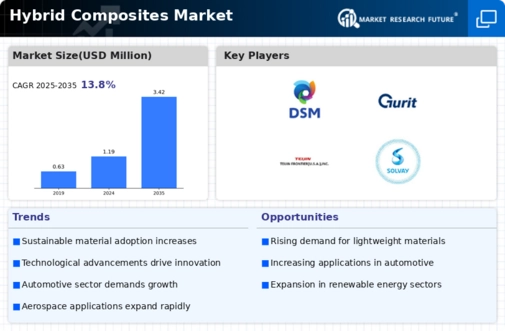Market Analysis
In-depth Analysis of Hybrid Composites Market Industry Landscape
The Hybrid Composites Market operates within a dynamic framework influenced by a variety of factors that collectively shape its growth and trends. Hybrid composites, a combination of two or more different types of reinforcing fibers, such as carbon, glass, or aramid, embedded in a matrix material, find extensive applications in industries ranging from aerospace and automotive to construction. The market dynamics of hybrid composites are intricately linked to trends in end-user industries, technological advancements, environmental considerations, and global economic conditions.
One of the driving forces behind the hybrid composites market is the demand from the aerospace and automotive sectors. As industries seek lightweight materials to enhance fuel efficiency and overall performance, hybrid composites offer a compelling solution. The dynamics of the hybrid composites market respond to the increasing demand for materials that combine the strength of carbon fibers with the cost-effectiveness of glass fibers, meeting the stringent requirements of these high-performance industries.
Technological advancements play a pivotal role in shaping the hybrid composites market dynamics. Ongoing research and development efforts focus on enhancing the performance characteristics of hybrid composites, including improvements in strength, durability, and manufacturability. Innovations in manufacturing processes, such as automated lay-up techniques and advanced resin formulations, contribute to the production of high-quality hybrid composite components. The market dynamics adapt to these technological breakthroughs, with companies striving to provide innovative solutions that meet the evolving needs of diverse industries.
Environmental considerations are increasingly influencing the hybrid composites market dynamics. As sustainability becomes a key driver in material selection, the market responds with a growing emphasis on eco-friendly composites. Hybrid composites with bio-based or recycled reinforcing fibers gain traction, aligning with the broader trend towards green and sustainable materials. Companies operating in the hybrid composites market must navigate the evolving landscape of environmental regulations and consumer preferences to maintain a competitive edge.
Global economic conditions and industrial activities further contribute to the dynamics of the hybrid composites market. Economic growth leads to increased demand for lightweight and high-strength materials in construction, transportation, and infrastructure projects. Conversely, economic downturns may lead to a temporary reduction in industrial activities, impacting the demand for hybrid composites. The cyclical nature of the economy adds an element of unpredictability to market trends.
The regulatory landscape is another key factor influencing the hybrid composites market dynamics. Compliance with safety and quality standards, particularly in industries like aerospace and automotive, becomes integral to the competitive positioning of companies within the market. Regulations related to material specifications, fire resistance, and environmental impact guide the development and adoption of hybrid composites. Companies must stay attuned to evolving regulatory requirements to navigate the complex landscape and ensure market compliance.
Market dynamics are also influenced by the competitive landscape and regional variations. The geographical distribution of manufacturing facilities, raw material availability, and the concentration of end-user industries impact the competitiveness of companies in specific regions. Global players often tailor their strategies to address regional variations and maintain a strong market presence. The level of competition and collaboration within the hybrid composites market contribute to the overall dynamics of the industry.







Leave a Comment